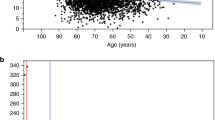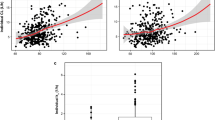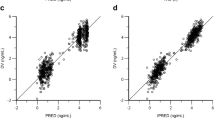Abstract
Background and Objective
Dihydropyrimidine dehydrogenase (DPD) is the initial enzyme in the catabolism of 5-fluorouracil (5FU) and DPD deficiency is an important pharmacogenetic syndrome. So far, only very limited information is available regarding the pharmacokinetics of 5FU in patients with a (partial) DPD deficiency and no limited sampling models have been developed taking into account the non-linear pharmacokinetic behaviour of 5FU. The aim of this study was to evaluate the pharmacokinetics of 5FU and to develop a limited sampling strategy to detect decreased 5FU elimination in patients with a c.1905+1G>A-related DPD deficiency.
Methods
Thirty patients, heterozygous for the C.1905+1G>A mutation in DPYD, and 18 control patients received a dose of 5FU 300 mg/m2 and/or 5FU 450 mg/m2, followed by pharmacokinetic analysis of the 5FU plasma levels. A population pharmacokinetic analysis was performed in order to develop a compartmental pharmacokinetic model suitable for a limited sampling strategy. Clinical aspects of treating DPD-deficient patients with 5FU-based chemotherapy were assessed from the retrospectively collected clinical data.
Results
In a two-compartment model with Michaelis-Menten elimination, the mean maximum enzymatic conversion capacity (Vmax) value was 40% lower in DPD-deficient patients compared with controls (p < 0.001). Using a limited sampling strategy, with Vmax values calculated from 5FU concentrations at 30 or 60 minutes, significant differences were observed between DPD-deficient patients and controls at both dose levels (p < 0.001). The positive predictive value and negative predictive value for Vmax, calculated from 5FU levels at 60 minutes, were 96% and 88%, respectively, in patients treated with a single dose of 5FU 300 mg/m2. All seven DPD-deficient patients (two males and five females) who had been genotyped prior to initiation of standard 5FU-containing chemotherapy developed grade 3–4 toxicity, with one case of lethal toxicity in a female patient. No grade 4 toxicity or lethal outcome was observed in 13 DPD-deficient patients treated with reduced doses of 5FU. The average dose of 5FU in DPD-deficient patients with mild toxicity (grade ≤2) was 61 ± 16% of the normal 5FU dose (n= 10).
Conclusions
Profound differences in the elimination of 5FU could be detected between DPD-deficient patients and control patients. Pharmacokinetic 5FU profiling, using a single 5FU concentration at 60 minutes, may be useful for identification of DPD-deficient patients in order to reduce severe toxicity. Furthermore, treatment of DPD-deficient patients with standard 5FU-containing chemotherapy was associated with severe (lethal) toxicity.








Similar content being viewed by others
References
Meyerhardt JA, Mayer RJ. Systemic therapy for colorectal cancer. N Engl J Med 2005; 352: 476–87
Twelves C, Wong A, Nowacki MP, et al. Capecitabine as adjuvant treatment for stage III colon cancer. N Engl J Med 2005; 352: 2696–704
Heggie GD, Sommadossi JP, Cross DS, et al. Clinical pharmacokinetics of 5-fluorouracil and its metabolites in plasma, urine, and bile. Cancer Res 1987; 47: 2203–6
Mattison LK, Soong R, Diasio RB. Implications of dihydropyrimidine dehydrogenase on 5-fluorouracil pharmacogenetics and pharmacogenomics. Pharmacogenomics 2002; 3: 485–92
van Kuilenburg ABP. Dihydropyrimidine dehydrogenase and the efficacy and toxicity of 5-fluorouracil. Eur J Cancer 2004; 40: 939–50
van Kuilenburg ABP, Haasjes J, Richel DJ, et al. Clinical implications of dihydropyrimidine dehydrogenase (DPD) deficiency in patients with severe 5-fluorouracil-associated toxicity: identification of new mutations in the DPD gene. Clin Cancer Res 2000; 6: 4705–12
Milano GA, Etienne MC, Pierrefite V, et al. Dihydropyrimidine dehydrogenase deficiency and fluorouracil-related toxicity. Br J Cancer 1999; 79: 627–30
Ciccolini J, Mercier C, Evrard A, et al. A rapid and inexpensive method for anticipating severe toxicity to fluorouracil and fluorouracil-based chemotherapy. Ther Drug Monit 2006; 28: 678–85
Morel A, Boisdron-Celle M, Fey L, et al. Clinical relevance of different dihydropyrimidine dehydrogenase gene single nucleotide polymorphisms on 5-fluorouracil tolerance. Mol Cancer Ther 2006; 5: 2895–904
Schwab M, Zanger UM, Marx C, et al. Role of genetic and nongenetic factors for fluorouracil treatment-related severe toxicity: a prospective clinical trial by the German 5-FU Toxicity Study Group. J Clin Oncol 2008; 26: 2131–8
Etienne MC, Lagrange JL, Dassonville O, et al. Population study of dihydropyrimidine dehydrogenase in cancer patients. J Clin Oncol 1994; 12: 2248–53
Deenen MJ, Tol J, Burylo AM, et al. Relationship between single nucleotide polymorphisms and haplotypes in DPYD and toxicity and efficacy of capecitabine in advanced colorectal cancer. Clin Cancer Res 2011 May 15; 17(10): 3455–68
Diasio RB, Beavers TL, Carpenter JT. Familial deficiency of dihydropyrimidine dehydrogenase: biochemical basis for familial pyrimidinemia and severe 5-fluorouracil-induced toxicity. J Clin Invest 1988; 81: 47–51
Codacci-Pisanelli G, Pinedo HM, Lankelma J, et al. Pharmacokinetics of bolus 5-fluorouracil: relationship between dose, plasma concentrations, area-under-the-curve and toxicity. J Chemother 2005; 17: 315–20
van Kuilenburg ABP, Maring JG, Schalhorn A, et al. Pharmacokinetics of 5-fluorouracil in patients heterozygous for the IVS14+1G>A mutation in the dihydropyrimidine dehydrogenase gene. Nucleos Nucleot Nucleic Acids 2008; 27: 692–8
Maring JG, van Kuilenburg ABP, Haasjes J, et al. Reduced 5-FU clearance in a patient with low DPD activity due to heterozygosity for a mutant allele of the DPYD gene. Br J Cancer 2002; 86: 1028–33
Terret C, Erdociain E, Guimbaud R, et al. Dose and time dependencies of 5-fluorouracil pharmacokinetics. Clin Pharmacol Ther 2000; 68: 270–9
Raida M, Schwabe W, Häusler P, et al. Prevalence of a common point mutation in the dihydropyrimidine dehydrogenase (DPD) gene within the 5′-splice donor site of intron 14 in patients with severe 5-fluorouracil (5-FU)- related toxicity compared with controls. Clin Cancer Res 2001; 7: 2832–9
Schalhorn A, Peyerl G, Denecke H. Pharmacokinetics of 5-fluorouracil during isolated liver perfusion. Regional Cancer Treatment 1988; 1: 21–7
Proost JH, Meijer DK. MW/Pharm, an integrated software package for drug dosage regimen calculation and therapeutic drug monitoring. Comput Biol Med 1992; 22: 155–63
Proost JH, Eleveld DJ. Performance of an iterative two-stage Bayesian technique for population pharmacokinetic analysis of rich data sets. Pharm Res 2006; 23: 2748–59
Maring JG, Schouten L, Greijdanus B, et al. A simple and sensitive fully validated HPLC-UV method for the determination of 5-fluorouracil and its metabolite 5,6-dihydrofluorouracil in plasma. Ther Drug Monit 2005; 27: 25–30
Maring JG, Piersma H, van Dalen A, et al. Extensive hepatic replacement due to liver metastases has no effect on 5-fluorouracil pharmacokinetics. Cancer Chemother Pharmacol 2003; 51: 167–73
Akobeng AK. Understanding diagnostic tests 3: receiver operating characteristic curves. Acta Paediatr 2007; 96: 644–7
Wei X, McLeod HL, McMurrough J, et al. Molecular basis of the human dihydropyrimidine dehydrogenase deficiency and 5-fluorouracil toxicity. J Clin Invest 1996; 98: 610–5
Vreken P, van Kuilenburg ABP, Meinsma JR, et al. A point mutation in an invariant splice donor site leads to exon skipping in two unrelated Dutch patients with dihydropyrimidine dehydrogenase deficiency. J Inherit Metab Dis 1996; 19: 645–54
van Kuilenburg ABP, Vreken P, Abeling NGGM, et al. Genotype and phenotype in patients with dihydropyrimidine dehydrogenase deficiency. Hum Genet 1999; 104: 1–9
van Kuilenburg ABP, Meinsma JR, Zoetekouw L, et al. Increased risk of grade IV neutropenia after administration of 5-fluorouracil due to a dihydropyrimidine dehydrogenase deficiency: high prevalence of the IVS14+1G>A mutation. Int J Cancer 2002; 101: 253–8
Gusella M, Ferrazzi E, Ferrari M, et al. New limited sampling strategy for determining 5-fluorouracil area under the concentration-time curve after rapid intravenous bolus. Ther Drug Monit 2002; 24: 425–31
Di Paolo A, Danesi R, Vannozzi F, et al. Limited sampling model for the analysis of 5-fluorouracil pharmacokinetics in adjuvant chemotherapy for colorectal cancer. Clin Pharmacol Ther 2002; 72: 627–37
Bocci G, Danesi R, Di Paolo AD, et al. Comparative pharmacokinetic analysis of 5-fluorouracil and its major metabolite 5-fluoro-5,6-dihydrouracil after conventional and reduced test dose in cancer patients. Clin Cancer Res 2000; 6: 3032–7
Bocci G, Barbara C, Vannozzi F, et al. A pharmacokinetic-based test to prevent severe 5-fluorouracil toxicity. Clin Pharmacol Ther 2006; 80: 384–95
Boisdron-Celle M, Remaud G, Traore S, et al. 5-Fluorouracil-related severe toxicity: a comparison of different methods for the pretherapeutic detection of dihydropyrimidine dehydrogenase deficiency. Cancer Lett 2007; 249: 271–82
Mattison LK, Ezzeldin H, Carpenter M, et al. Rapid identification of dihydropyrimidine dehydrogenase deficiency by using a novel 2–13C-uracil breath test. Clin Cancer Res 2004; 10: 2652–8
van Kuilenburg ABP. Screening for dihydropyrimidine dehydrogenase deficiency: to do or not to do, that’s the question. Cancer Invest 2006; 24: 215–7
Ciccolini J, Gross E, Dahan L, et al. Routine dihydropyrimidine dehydrogenase testing for anticipating 5-fluorouracil-related severe toxicities: hype or hope? Clin Colorectal Cancer 2010; 9: 224–8
van Staveren MC, Theeuwes-Oonk B, Guchelaar HJ, et al. Pharmacokinetics of orally administered uracil in healthy volunteers and in DPD-deficient patients, a possible tool for screening of DPD deficiency. Cancer Chemother Pharmacol 2011; 68: 1611–7
Collie-Duguid ESR, Etienne MC, Milano GA, et al. Known variant DPYD alleles do not explain DPD deficiency in cancer patients. Pharmacogenetics 2000; 10: 217–23
van Kuilenburg ABP, Meijer J, Mul ANPM, et al. Intragenic deletions and a deep intronic mutation affecting pre-mRNA splicing in the dihydropyrimidine dehydrogenase gene as novel mechanisms causing 5-fluorouracil toxicity. Hum Genet 2010; 128: 529–38
Yen JL, McLeod HL. Should DPD analysis be required prior to prescribing fluoropyrimidines? Eur J Cancer 2007; 43: 1011–2
Di Paolo A, Danesi R, Falcone A, et al. Relationship between 5-fluorouracil disposition, toxicity and dihydropyrimidine dehydrogenase activity in cancer patients. Ann Oncol 2001; 12: 1301–6
Gamelin E, Boisdron-Celle M. Dose monitoring of 5-fluorouracil in patients with colorectal or head and neck cancer: status of the art. Crit Rev Oncol Hematol 1999; 30: 71–9
Gusella M, Crepaldi G, Barile C, et al. Pharmacokinetic and demographic markers of 5-fluorouracil toxicity in 181 patients on adjuvant therapy for colorectal cancer. Ann Oncol 2006; 17: 1656–60
Gamelin E, Delva R, Jacob J, et al. Individual fluorouracil dose adjustment based on pharmacokinetic follow-up compared with conventional dosage: results of a multicenter randomized trial of patients with metastatic colorectal cancer. J Clin Oncol 2008; 26: 2099–105
Swen JJ, Nijenhuis M, de Boer A, et al. Pharmacogenetics: from bench to byte: an update of guidelines. Clin Pharmacol Ther 2011; 89: 662–73
Acknowledgements
Ms Karin Heil is thanked for her skillful experimental assistance.
Conflict of interests: D. Behnke, W. Schwabe and K. Jabschinsky are employees of Oncoscreen GmbH, which performs screening for the c.1905+1G>A mutation on a commercial basis. P. Häusler is a former employee of Oncoscreen GmbH. The other authors have no conflicts of interest that are directly relevant to the content of this study.
Author information
Authors and Affiliations
Corresponding author
Rights and permissions
About this article
Cite this article
van Kuilenburg, A.B.P., Häusler, P., Schalhorn, A. et al. Evaluation of 5-Fluorouracil Pharmacokinetics in Cancer Patients with a C.1905+1G>A Mutation in DPYD by Means of a Bayesian Limited Sampling Strategy. Clin Pharmacokinet 51, 163–174 (2012). https://doi.org/10.1007/BF03257473
Published:
Issue Date:
DOI: https://doi.org/10.1007/BF03257473




